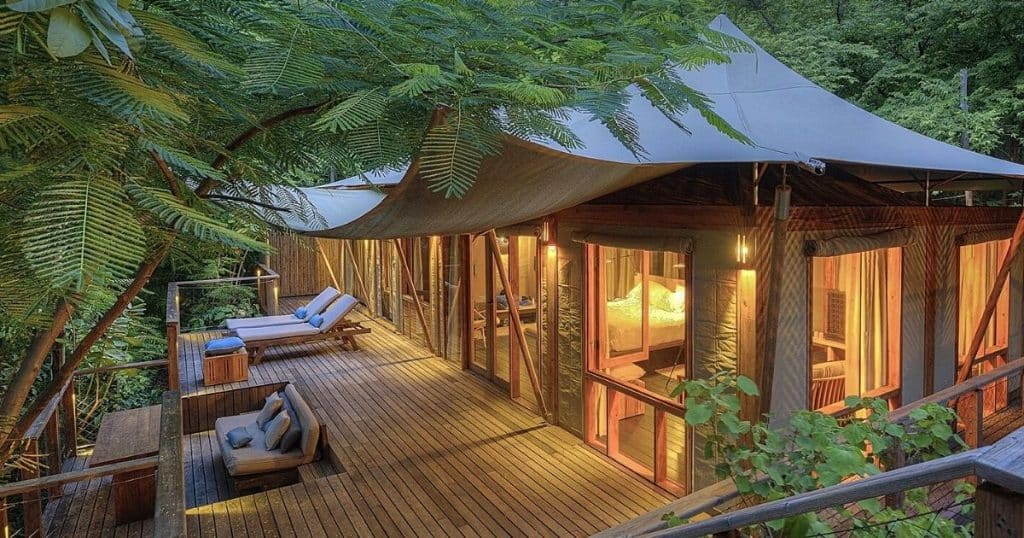In the ever-evolving hospitality industry, hotels continuously seek innovative ways to enhance guest experiences. One transformative approach gaining prominence is biophilic design, which integrates natural elements into built environments. This design philosophy aims to foster a connection between people and nature, promoting well-being and relaxation. Here’s an in-depth look at how hotels can leverage biophilic principles to create enriching and restorative guest experiences.

Understanding Biophilic Design
Biophilic design is grounded in the concept that humans have an innate affinity for nature. This connection, known as biophilia, suggests that incorporating natural elements into our living and working spaces can significantly improve mental and physical health. In hotel design, biophilic principles can be applied through various strategies, from incorporating natural materials and maximizing natural light to creating green spaces and ensuring visual connections to nature.
Key Principles of Biophilic Design in Hotels
- Natural Light and Views
- Maximizing Natural Light: Large windows, skylights, and glass doors can flood interiors with natural light, creating a warm and inviting atmosphere. Natural light not only enhances mood but also helps regulate circadian rhythms, improving sleep quality for guests.
- Views of Nature: Positioning windows to offer views of gardens, water features, or natural landscapes can create a calming effect. Even urban hotels can achieve this by incorporating rooftop gardens or vertical green walls visible from guest rooms and common areas.
- Natural Materials and Textures
- Wood and Stone: Using materials such as wood, stone, and bamboo can evoke a sense of being in nature. These materials can be incorporated into flooring, furniture, and accent walls, providing a tactile connection to the natural world.
- Textures and Patterns: Incorporating textures and patterns found in nature, such as leaf motifs or water-inspired designs, can enhance the sensory experience. These can be featured in fabrics, wall coverings, and decorative elements.
- Indoor Greenery
- Plants and Green Walls: Indoor plants and living walls can purify the air and bring a sense of tranquility to hotel spaces. Strategically placed greenery in lobbies, corridors, and guest rooms can create a serene environment.
- Botanical Themes: Incorporating botanical themes in design, such as floral artwork or nature-inspired color palettes, can enhance the overall aesthetic and reinforce the connection to nature.
- Water Features
- Fountains and Waterfalls: The sound and sight of water have a soothing effect. Installing indoor fountains, waterfalls, or even small water features can create a peaceful ambiance.
- Pools and Spas: Designating areas for pools and spas that incorporate natural elements can provide guests with a sanctuary for relaxation and rejuvenation.
- Natural Shapes and Forms
- Organic Forms: Incorporating curves and organic shapes, rather than rigid, linear designs, can mimic the natural environment. Furniture, pathways, and architectural elements can be designed with flowing lines to create a more harmonious space.
- Biomimicry: Drawing inspiration from nature’s forms and processes can lead to innovative and sustainable design solutions. For example, hotel structures that mimic the natural cooling effects of termite mounds can enhance energy efficiency.
Benefits of Biophilic Design for Guests
- Enhanced Well-Being
- Stress Reduction: Natural elements can lower stress levels, promoting relaxation and mental clarity. This can be particularly beneficial for guests looking to unwind during their stay.
- Improved Mood: Exposure to nature can boost mood and overall happiness. Guests are likely to feel more positive and refreshed after spending time in biophilic spaces.
- Better Physical Health
- Improved Air Quality: Indoor plants can improve air quality by filtering pollutants and increasing oxygen levels. This can enhance respiratory health and overall well-being.
- Enhanced Sleep Quality: Natural light exposure during the day can help regulate sleep-wake cycles, leading to better sleep quality for guests.
- Increased Connection to Nature
- Sensory Engagement: Biophilic design engages multiple senses, from the visual appeal of greenery to the soothing sounds of water. This multisensory experience can deepen guests’ connection to the natural world.
- Mindfulness and Presence: Being in a space that reflects nature can encourage mindfulness and a sense of presence, allowing guests to fully immerse themselves in the moment.
Case Studies of Biophilic Design in Hotels
- 1 Hotel Brooklyn Bridge, New York
- This eco-luxury hotel incorporates reclaimed materials, living green walls, and stunning views of the East River and Manhattan skyline. The design emphasizes sustainability and a seamless connection to nature.
- Six Senses Ninh Van Bay, Vietnam
- Nestled in a secluded bay, this resort integrates natural elements into its architecture, from thatched roofs to wooden structures. The design prioritizes harmony with the surrounding landscape, offering guests an immersive natural experience.
- Parkroyal Collection Pickering, Singapore
- Known for its iconic sky gardens, this hotel features lush greenery and innovative vertical gardens that span the building. The biophilic design enhances the urban environment, providing a green oasis in the heart of the city.
Implementing Biophilic Design in Your Hotel
- Conduct a Site Analysis
- Assess the natural features and potential of your hotel’s location. Identify opportunities to incorporate natural elements and maximize views of the surrounding landscape.
- Engage with Experts
- Collaborate with architects, designers, and biophilic design experts to create a comprehensive plan. Their expertise can help seamlessly integrate biophilic principles into your hotel’s design.
- Prioritize Sustainability
- Biophilic design and sustainability go hand in hand. Choose sustainable materials and practices to enhance your hotel’s environmental credentials while promoting guest well-being.
- Create a Biophilic Culture
- Educate staff and guests about the benefits of biophilic design. Encourage mindfulness and connection to nature through programming and amenities that highlight natural elements.
When thoughtfully executed, design philosophies like biophilic principles become part of a broader luxury hotel marketing approach that strengthens brand perception, guest experience, and long-term loyalty. Many luxury properties rely on a specialized hospitality marketing agency to ensure experiential design and guest well-being initiatives are communicated consistently across digital channels.
Designing hotel spaces with biophilic principles offers a powerful way to enhance guest well-being, creating environments that are not only aesthetically pleasing but also deeply restorative. By integrating natural elements, maximizing natural light, and fostering a connection to nature, hotels can provide guests with an unparalleled experience that promotes relaxation, health, and happiness. Embracing biophilic design is a step towards creating hotels that truly nurture the mind, body, and soul.

